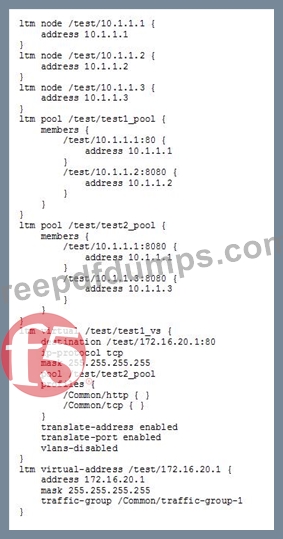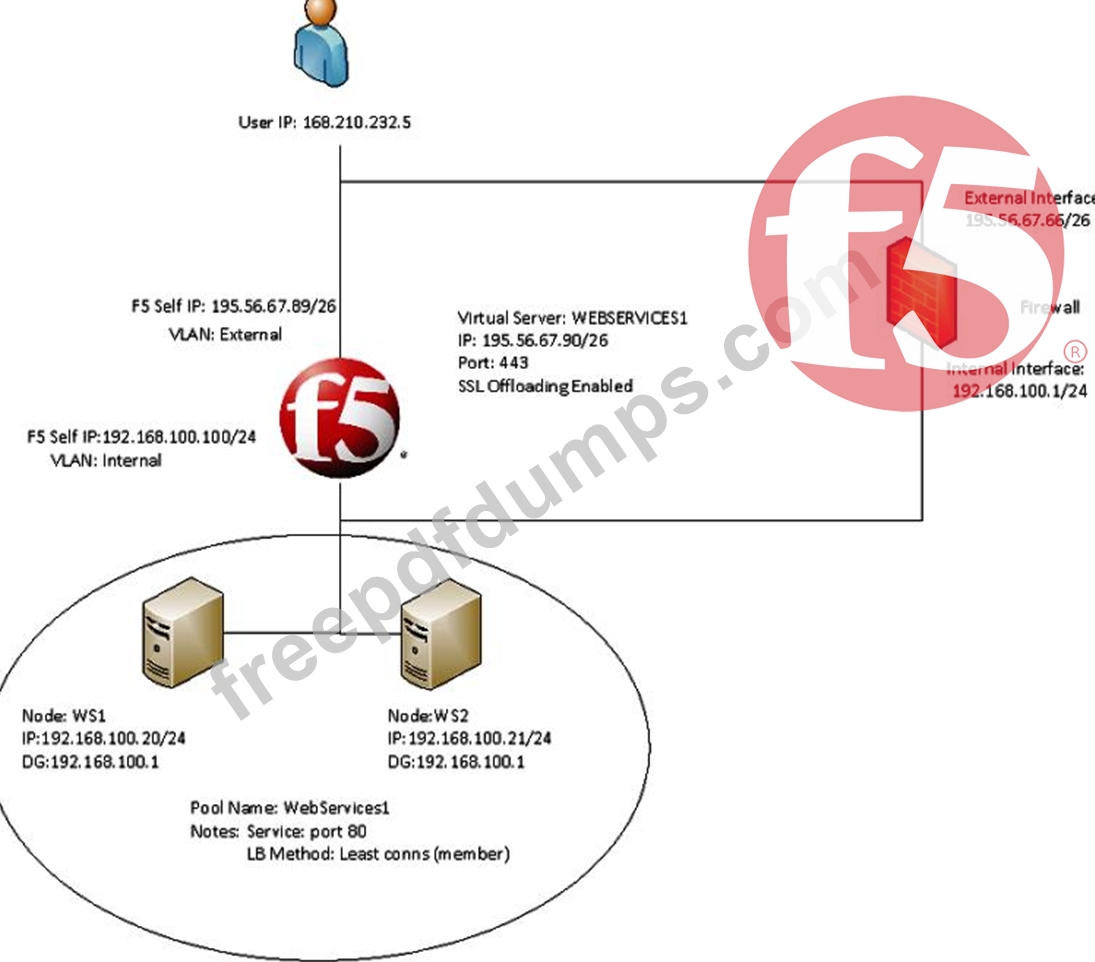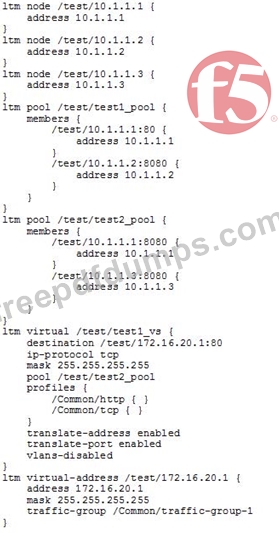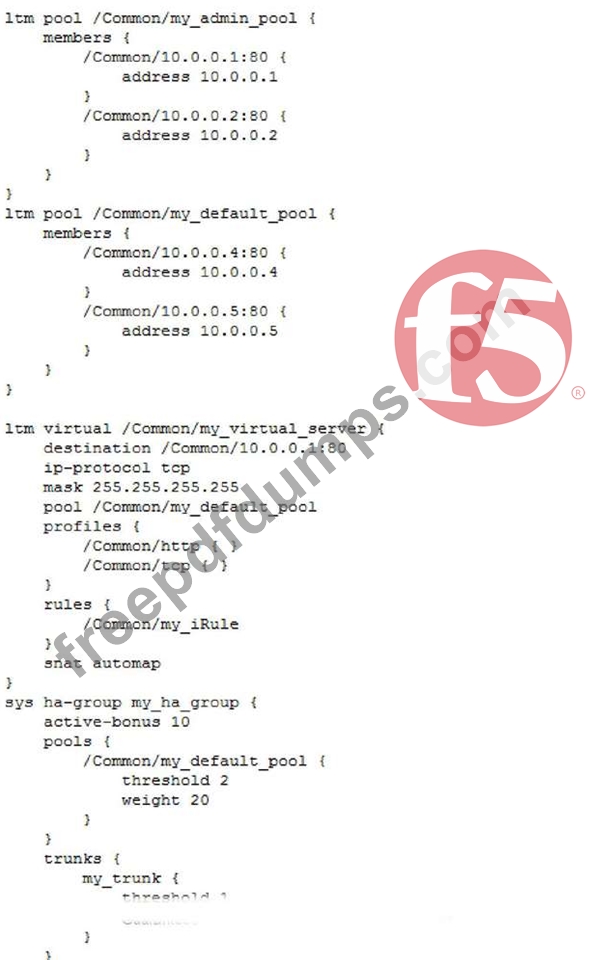301b Exam Question 86
The LTM device is configured to provide load balancing to a set of web servers that implement access control lists (ACL) based on the source IP address of the client. The ACL is at the network level and the web server is configured to send a TCP reset back to the client if it is NOT permitted to connect.
The virtual server is configured with the default OneConnect profile.
The ACL is defined on the web server as:
Permit: 192.168.136.0/24
Deny: 192.168.116.0/24
The packet capture is taken of two individual client flows to a virtual server with IP address 192.168.136.100.
Client A - Src IP 192.168.136.1 - Virtual Server 192.168.136.100:
Clientside:
09:35:11.073623 IP 192.168.136.1.55684 > 192.168.136.100.80: S 869998901:869998901(0) win 8192 <mss
1460,nop,wscale 2,nop,nop,sackOK>
09:35:11.073931 IP 192.168.136.100.80 > 192.168.136.1.55684: S 2273668949:2273668949(0) ack
869998902 win 4380 <mss 1460,nop,wscale 0,sackOK,eol>
09:35:11.074928 IP 192.168.136.1.55684 > 192.168.136.100.80: . ack 1 win 16425
09:35:11.080936 IP 192.168.136.1.55684 > 192.168.136.100.80: P 1:299(298) ack 1 win 16425
09:35:11.081029 IP 192.168.136.100.80 > 192.168.136.1.55684: . ack 299 win 4678 Serverside:
09:35:11.081022 IP 192.168.136.1.55684 > 192.168.116.128.80: S 685865802:685865802(0) win 4380 <mss
1460,nop,wscale 0,sackOK,eol>
09:35:11.081928 IP 192.168.116.128.80 > 192.168.136.1.55684: S 4193259095:4193259095(0) ack
685865803 win 5840 <mss 1460,nop,nop,sackOK,nop,wscale 6>
09:35:11.081943 IP 192.168.136.1.55684 > 192.168.116.128.80: . ack 1 win 4380
09:35:11.081955 IP 192.168.136.1.55684 > 192.168.116.128.80: P 1:299(298) ack 1 win 4380
09:35:11.083765 IP 192.168.116.128.80 > 192.168.136.1.55684: . ack 299 win 108 Client B - Src IP 192.168.116.1 - Virtual Server 192.168.136.100:
Clientside:
09:36:11.244040 IP 192.168.116.1.55769 > 192.168.136.100.80: S 3320618938:3320618938(0) win 8192
<mss 1460,nop,wscale 2,nop,nop,sackOK>
09:36:11.244152 IP 192.168.136.100.80 > 192.168.116.1.55769: S 3878120666:3878120666(0) ack
3320618939 win 4380 <mss 1460,nop,wscale 0,sackOK,eol>
09:36:11.244839 IP 192.168.116.1.55769 > 192.168.136.100.80: . ack 1 win 16425
09:36:11.245830 IP 192.168.116.1.55769 > 192.168.136.100.80: P 1:299(298) ack 1 win 16425
09:36:11.245922 IP 192.168.136.100.80 > 192.168.116.1.55769: . ack 299 win 4678 Serverside:
09:36:11.245940 IP 192.168.136.1.55684 > 192.168.116.128.80: P 599:897(298) ack 4525 win 8904
09:36:11.247847 IP 192.168.116.128.80 > 192.168.136.1.55684: P 4525:5001(476) ack 897 win 142 Why was the second client flow permitted by the web server?
The virtual server is configured with the default OneConnect profile.
The ACL is defined on the web server as:
Permit: 192.168.136.0/24
Deny: 192.168.116.0/24
The packet capture is taken of two individual client flows to a virtual server with IP address 192.168.136.100.
Client A - Src IP 192.168.136.1 - Virtual Server 192.168.136.100:
Clientside:
09:35:11.073623 IP 192.168.136.1.55684 > 192.168.136.100.80: S 869998901:869998901(0) win 8192 <mss
1460,nop,wscale 2,nop,nop,sackOK>
09:35:11.073931 IP 192.168.136.100.80 > 192.168.136.1.55684: S 2273668949:2273668949(0) ack
869998902 win 4380 <mss 1460,nop,wscale 0,sackOK,eol>
09:35:11.074928 IP 192.168.136.1.55684 > 192.168.136.100.80: . ack 1 win 16425
09:35:11.080936 IP 192.168.136.1.55684 > 192.168.136.100.80: P 1:299(298) ack 1 win 16425
09:35:11.081029 IP 192.168.136.100.80 > 192.168.136.1.55684: . ack 299 win 4678 Serverside:
09:35:11.081022 IP 192.168.136.1.55684 > 192.168.116.128.80: S 685865802:685865802(0) win 4380 <mss
1460,nop,wscale 0,sackOK,eol>
09:35:11.081928 IP 192.168.116.128.80 > 192.168.136.1.55684: S 4193259095:4193259095(0) ack
685865803 win 5840 <mss 1460,nop,nop,sackOK,nop,wscale 6>
09:35:11.081943 IP 192.168.136.1.55684 > 192.168.116.128.80: . ack 1 win 4380
09:35:11.081955 IP 192.168.136.1.55684 > 192.168.116.128.80: P 1:299(298) ack 1 win 4380
09:35:11.083765 IP 192.168.116.128.80 > 192.168.136.1.55684: . ack 299 win 108 Client B - Src IP 192.168.116.1 - Virtual Server 192.168.136.100:
Clientside:
09:36:11.244040 IP 192.168.116.1.55769 > 192.168.136.100.80: S 3320618938:3320618938(0) win 8192
<mss 1460,nop,wscale 2,nop,nop,sackOK>
09:36:11.244152 IP 192.168.136.100.80 > 192.168.116.1.55769: S 3878120666:3878120666(0) ack
3320618939 win 4380 <mss 1460,nop,wscale 0,sackOK,eol>
09:36:11.244839 IP 192.168.116.1.55769 > 192.168.136.100.80: . ack 1 win 16425
09:36:11.245830 IP 192.168.116.1.55769 > 192.168.136.100.80: P 1:299(298) ack 1 win 16425
09:36:11.245922 IP 192.168.136.100.80 > 192.168.116.1.55769: . ack 299 win 4678 Serverside:
09:36:11.245940 IP 192.168.136.1.55684 > 192.168.116.128.80: P 599:897(298) ack 4525 win 8904
09:36:11.247847 IP 192.168.116.128.80 > 192.168.136.1.55684: P 4525:5001(476) ack 897 win 142 Why was the second client flow permitted by the web server?
301b Exam Question 87
-- Exhibit -

-- Exhibit --
Refer to the exhibit.
An LTM Specialist is reviewing the 'test' partition.
Which objects, in order, can be removed from the partition?

-- Exhibit --
Refer to the exhibit.
An LTM Specialist is reviewing the 'test' partition.
Which objects, in order, can be removed from the partition?
301b Exam Question 88
-- Exhibit -

-- Exhibit --
Refer to the exhibit.
Users receive an error when attempting to connect to the website https://website.com. The website has a DNS record of 195.56.67.90. The upstream ISP has confirmed that there is nothing wrong with the routing between the user and the LTM device.
The following tcpdump outputs have been captured:
External Vlan, filtered on IP 168.210.232.5
00:25:07.598519 IP 168.210.232.5.33159 > 195.56.67.90.https: S 1920647964:1920647964(0) win 8192
<mss 1450,nop,nop,sackOK>
00:25:07.598537 IP 195.56.67.90.https > 168.210.232.5.33159: S 2690691360:2690691360(0) ack
1920647965 win 4350 <mss 1460,sackOK,eol>
00:25:07.598851 IP 168.210.232.5.33160 > 195.56.67.90.https: S 2763858764:2763858764(0) win 8192
<mss 1450,nop,nop,sackOK>
00:25:07.598858 IP 195.56.67.90.https > 168.210.232.5.33160: S 1905576176:1905576176(0) ack
2763858765 win 4350 <mss 1460,sackOK,eol>
Internal Vlan, filtered on IP 168.210.232.5
00:31:46.171124 IP 168.210.232.5.33202 > 192.168.100.20.http: S 2389057240:2389057240(0) win 4380
<mss 1460,nop,wscale 0,sackOK,eol>
What is the problem?

-- Exhibit --
Refer to the exhibit.
Users receive an error when attempting to connect to the website https://website.com. The website has a DNS record of 195.56.67.90. The upstream ISP has confirmed that there is nothing wrong with the routing between the user and the LTM device.
The following tcpdump outputs have been captured:
External Vlan, filtered on IP 168.210.232.5
00:25:07.598519 IP 168.210.232.5.33159 > 195.56.67.90.https: S 1920647964:1920647964(0) win 8192
<mss 1450,nop,nop,sackOK>
00:25:07.598537 IP 195.56.67.90.https > 168.210.232.5.33159: S 2690691360:2690691360(0) ack
1920647965 win 4350 <mss 1460,sackOK,eol>
00:25:07.598851 IP 168.210.232.5.33160 > 195.56.67.90.https: S 2763858764:2763858764(0) win 8192
<mss 1450,nop,nop,sackOK>
00:25:07.598858 IP 195.56.67.90.https > 168.210.232.5.33160: S 1905576176:1905576176(0) ack
2763858765 win 4350 <mss 1460,sackOK,eol>
Internal Vlan, filtered on IP 168.210.232.5
00:31:46.171124 IP 168.210.232.5.33202 > 192.168.100.20.http: S 2389057240:2389057240(0) win 4380
<mss 1460,nop,wscale 0,sackOK,eol>
What is the problem?
301b Exam Question 89
-- Exhibit- -- Exhibit -

Refer to the exhibit.
An LTM Specialist is reviewing the 'test' partition.
Which objects, in order, can be removed from the partition?

Refer to the exhibit.
An LTM Specialist is reviewing the 'test' partition.
Which objects, in order, can be removed from the partition?
301b Exam Question 90
-- Exhibit-

-- Exhibit --
Refer to the exhibit.
A pair of LTM devices is configured for HA.
What happens if the pool member server with IP address 10.0.0.4 becomes totally
unresponsive to the active LTM device, but is still responsive to the standby LTM device?

-- Exhibit --
Refer to the exhibit.
A pair of LTM devices is configured for HA.
What happens if the pool member server with IP address 10.0.0.4 becomes totally
unresponsive to the active LTM device, but is still responsive to the standby LTM device?

